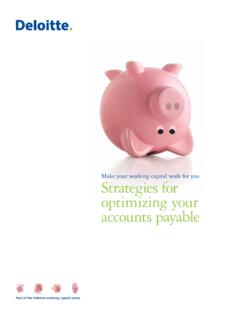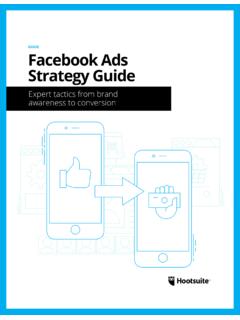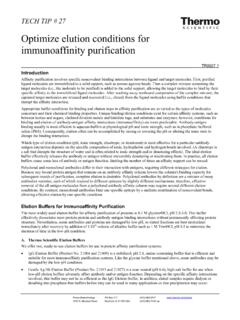Transcription of Negotiation Strategies
1 Negotiation Strategies Lesley Stolz, Business Development Outline Negotiation and Influencing Basics Negotiation Style Developing the Business Opportunity Progressing Negotiations From Agreed Terms to Binding Contract The Softer Side of Negotiation Take-Home Messages Negotiation is participatory Positional Negotiation is not effective Power in Negotiation comes from preparation Preparation is necessary prior to any interaction with the other party Ninety percent of the Negotiation process is done before the first meeting Listening is probably your most important skill to develop The Art of Effective Negotiation Know yourself Know your own organization Know the opposite party in good deal making, 90% of the real Negotiation happens before you sit down to negotiate effective Negotiation is 90% attitude and 10% technique Definitions and Guidelines Negotiation facilitates agreement when some of your interests are shared and some are opposed Negotiation is the process of evolving communication to get from opposition to consensus, manage conflict and reach agreement Negotiation principles apply as much to your internal team as they do to an outside party Definitions and Guidelines Negotiation and influencing skills are critical to getting the best deal, facilitating problem solving, gaining support and building co-operative relationships Negotiation is central to gaining agreement and exercising influence The ability to influence others and resolve conflict is at the core of successful business Definitions and Guidelines Negotiation is an integrated process requiring.
2 Effective communication Development of consensus (internal & external) Process Management Influence building and relationship development Success in Negotiation depends on confidence Confidence enables and arises from a) careful advance planning to maximize options and b) working creatively during the negotiations to optimize the outcome Success is ultimately measured by the potential contribution of a deal to the bottom line of your portfolio Sometimes the best deals are the ones not done! Preparation: The Elevator Pitch your first assignment as a BD person Template: We provide (state the nature of your product/service)..for (who is the target audience).. who want (what does this audience need)..and are looking for (what audience values). Most people aren t even aware that (what should they know but might not know to ask). We always offer (case building, foundation for differentiation) To help our audience make the best decisions possible, we offer _____ which contains (evidence) Modified from Monopolize your Marketplace by R.
3 Harshaw and Invigorate Negotiation Style We All Have an Individual Style Style is a consistent pattern of behaviors emanating from an individual and recognised by others Distinct negotiating styles Warm Tough Numbers Dealer The role of style in Negotiation enables us to understand and manage Ourselves Our internal team The opposite party Character as the Basis of Negotiation Style Style is influenced by innate character traits Style can be fine-tuned to adapt to different Negotiation scenarios - your fundamental character does not change Complementary styles make a successful negotiating team Adapting style can enhance and improve intra-team co-operation Where Does Our Style Come From? Genetics Upbringing Social background Education and training National culture Reaction and response to other people Professional experience No one fits exactly into one style, but most of us have a 60-80% fit with one To recognize your style, you need to look inside and find out how others see you Warm Style Pros for a negotiator Friendly, good listener Emphasizes common interests Constructive and helpful Informative and open Creates climate of confidence Patient, calm Supportive team player Trusts the advice of others Cons for a negotiator Interpersonal relations too important Difficulty saying no Can lose sight of own interests Conflict averse Trusting and na ve Deferential and apologetic May struggle under pressure or with responsibility May be perceived as weak Tough Style Pros for a negotiator States position assertively Dynamic.
4 Takes control Decisive and quick to act Seizes opportunity Takes the lead Rises to the challenge Gets the best for their side Cons for a negotiator Autocratic vs. team player Impulsive and impatient Inflexible and proud Overbearing Doesn t listen well: take it or leave it Quick to criticize, even colleagues Numbers Style Pros for a negotiator Facts, logic, detail oriented Methodical and systematic Persistent and patient Prepares well, manages risk Sticks to policy and procedures Weighs all alternatives Confident in own skills Cons for a negotiator Not intuitive with people Lacks creativity Expects to convince with logic Analysis paralysis Predictable: no surprises! Stubborn and resistant to change Fails to see other point of view Too literal: may miss golden opportunity Dealer Style Pros for a negotiator Socially skillful, charming, cheerfully cynical Avoids giving offence Adaptable, flexible, creative Persuasive, articulate Perseverant Thinks on feet Understands true win-win Seeks opportunities to make it work Cons for a negotiator A deal at any price: deal junkie Pushy Over solicitous: sucks-up Shifts position too fast, too often Alienates through talking too much Perceived as tricky, insincere, untrustworthy Fails to prepare, plan or listen properly Beyond style, all negotiators Have the willingness to prepare Enter negotiations with optimism and ambition, projecting high expectation and self confidence There is striking research evidence that people who expect more get more Have commitment to integrity and courtesy Even polar opposites are entitled to treatment with respect!
5 Develop proactive questioning and listening skills Make best use of questions, body language, interjections Develop supporting statements, clarifying statements & summarizing statements to elicit information and optimize communication Developing the Business Opportunity The Negotiation Process Know yourself & your organization: personal style, company strategy Know the product or technology and its position in the marketplace Know your potential partner: culture, strategy, management, markets First meeting(s) Communicate interests, issues and needs Identify the gaps Address needs, resolve the issues Close the gaps Close the deal Managing the process Due Diligence Definition of Need First know thyself Establish effective lines of communication to key stakeholders in your organization Build consensus on organization needs & strategy Develop BD objectives and priorities Establish criteria for Strategic Fit Proactive Reviews Forced ranking opportunity assessments Reactive Reviews Degree of fit with predefined criteria Develop Internal Consensus Technical Review Team With Project Owner (with operational responsibility) With Alliance Manager (if not Project Owner) Within Business Development Team With Project Stakeholders With Senior Management Use your powers of influence!
6 Strategic Planning & Business Development Manufacturing Operations Opportunity Analysis and Negotiation Team Parent Company & Affiliate Operations Finance and Accounting Sales and Marketing Strategy Legal, IP and Regulatory Executive Sponsorship Deal Team Concept Research and Development Establishment of Internal Corporate Objectives Define strategic purpose of partnering Cash Pipeline gap Experience in pre-clinical or clinical development Meet commercialization goals Define the market opportunity Elaborate commercial potential - be realistic, consult experts Understand competition, potential differentiators Develop financial model and understand sensitivity of key parameters; how changing the numbers changes the proportion of profit share between licensor and licensee Prepare strategic options as a decision tree and the financial implications of partnering at different development time-points Prepare a product life cycle plan Align Objectives to Potential Partners Is there one ideal partner for the opportunity?
7 Based on Strategy, capabilities, industry reputation, therapeutic focus, deal-making history Synergies with your organization obvious Candidate for Proactive Review Approach to Negotiation can be more targeted and customized to the ideal partner in question Or are there potentially many contenders? Earlier stage assets requiring initial exploratory research phase More effort required in initial finder phase, to identify partner with ideal strategic fit Candidate for Reactive Review Approach to Negotiation initially more general (one size fits all) then customized once probable partner identified Maintaining Alignment to Internal Corporate Objectives Create a communication plan within your company so the message is always the same Establish and communicate criteria for identifying potential partners and their fit to your organization Begin to define and structure the type of deal your organization is seeking Understand your Best Alternative to a Negotiated Agreement (BATNA)
8 Create a rough outline of a term sheet including ballpark figures for financial terms and trigger events for payments Analyze comparable deals Reaffirm your BATNA in the context of your draft term sheet Ensure the broad definition of the deal is communicated effectively internally Secure buy-in as early as possible in the process Visualize the Opportunity TARGET BATNA TARGET BATNA Bargaining Zone Their Needs your Needs OPENING POSITION Planning Tools Create a map of the issues note what a change in one issue will do to another Set your limits What is your BATNA? This will be the low end of your limit What is their BATNA? Difficult to estimate, but very important What is your target? your target should be ambitious without being ludicrous. It should be near their BATNA Set your first offer and ensure this is communicated to your key stakeholders internally Even if the other party offers the first term sheet, you must keep your first offer in mind Examples of Negotiation Issues License Payments Upfront, FTE support, success fees, milestones, royalties Activities of the Parties: obligations vs.
9 Responsibilities Other considerations (Quids?) Manufacture and supply (Bulk / Formulation / Fill / Finish) IP Inventorship / Prosecution / Enforcement Registration Rights Governance and Dispute Resolution Representations and Warranties Termination Interdependence of the Issues Termination Upfront Reps & Warranties Activities Supply Governance IP & Inventorship License Registrational rights Royalties Milestones Quids Planning Tools Make a chart of what issues or terms you will give up, what you must keep, what you want to get, and what could be a surprise. Create a chart of information that you will disclose to the other party, keep from the other party, want to get from the other party, and what would surprise you if they gave it to you. Remember, information is power in a Negotiation Give Get Keep Surprise Preparation for Initial Contact Establish the objective for the initial contact Have all your planning tools together and completed Information needs, possible scenarios, etc.
10 Prepare your introduction statement Envisaged relationship Balance of power Possible outcomes and probability of success Determine who should be contacted and who should make the contacts. Agree on one voice Make initial contact; assess and establish interest Discuss and agree next steps Transfer of non-confidential materials: have all relevant publications, patents, posters, etc ready in pdf form to send out upon request Define and agree time frame for review and follow-up period to enable you to meet internal expectations Building the Scientific Contact Define what your organization requires to build the foundation of a full binding agreement with the party Transfer of proprietary materials under an MTA? More collaborative involvement in a predefined Feasibility Study? Secure the necessary co-operation and buy in from your scientific and technical specialists Ensure your key individuals know their counterparts in the partner organization Keep technical achievability aligned to strategic intent, even at this early stage Work with your internal specialists to outline the workplan for this stage of the interaction Bear in mind that all provisions ( obligations, ownership of inventions, confidentiality, consequences of termination) must align with the intended terms of the eventual full agreement Guiding Principles Openly discuss needs and expectations of your organization Invite other party to describe their needs and expectations Establish agreement on scope & Key Success Factors which will guide decision-making in the project Codify into statement(s) that define the spirit as well as the intent of the desired relationship Overall Goal of Negotiation .






